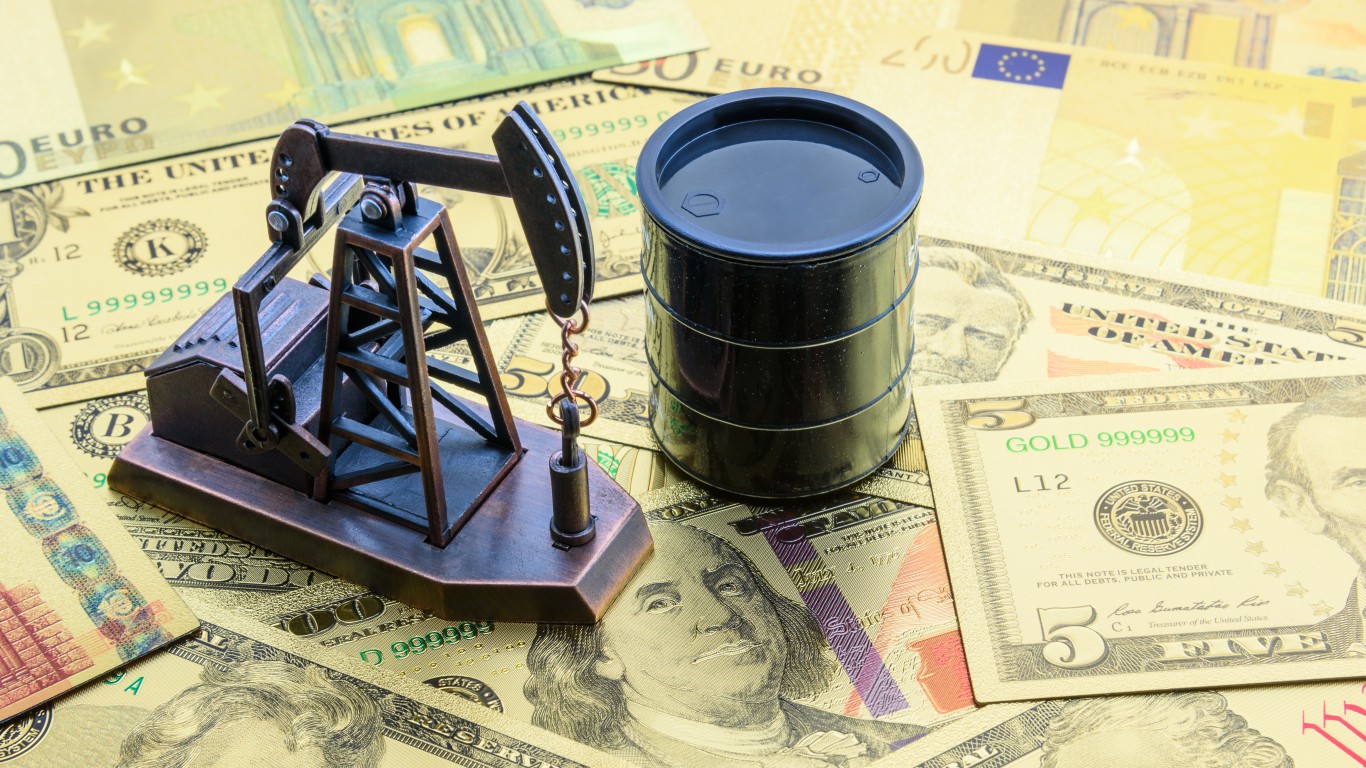
Last year was a tough one for oil and gas stocks. The Biden administration has made no secret of its plan to reverse the previous administration’s position on climate change and already has erased Trump’s approval for the Keystone XL pipeline and drilling for oil and gas on federal lands.
That doesn’t mean that investors should give up on fossil fuel stocks, according to analysts at BofA Securities, which last week either raised or reiterated Overweight ratings on some big energy stocks.
Some of that enthusiasm is related to the handsome dividends some of the energy stocks pay. Chevron Corp. (NYSE: CVX), for example, pays a current dividend yield of 5.8%, down slightly from its end of 2020 yield of around 6.05%, making it the highest-yielding stock in our Dogs of the Dow year-end summary.
Include a 43% jump in crude oil prices and concomitant increases in oil stocks, and investing in oil and gas companies looks a bit better as the economy tries to get back on its feet.
Cutting expenses, particularly capital spending, was the priority in 2020. When Chevron reported earnings last Friday, CEO Mike Wirth touted the company’s 35% year-over-year reduction in capital spending, which totaled some $1.4 billion. Chevron added $7.5 billion in new debt last year to help pay its $9.7 billion dividend expenses. The company’s full-year net loss totaled $5.6 billion.
Three more big oil companies are scheduled to report fourth-quarter and full-year results Tuesday morning.
BP
First up is BP PLC (NYSE: BP), the London-based supermajor that posted a replacement cost loss of nearly $19 billion in the first three quarters of the fiscal year. Its adjusted loss (what BP calls its underlying replacement cost) totaled $5.8 billion in the same period. BP recorded $9.8 billion in write-offs during the first three-quarters of 2020, most of it in the second quarter. BP also has cut its dividend to $0.315 per American depositary share (ADS), one of which is equal to six ordinary shares).
Analysts expect the company to post earnings per share (EPS) of $0.08 for the quarter and a loss per share of $1.33 for the full year. Fourth-quarter revenue is estimated at $46.6 billion, down by more than a third year over year, and full-year revenue is expected to fall by around 30% to $198 billion.
At a recent price of around $22 per ADS, the stock trades at a multiple of around 13.5 times expected 2021 earnings and 8.7 times expected EPS in 2022. The current 52-week range on the stock is $14.74 to $37.78, and the consensus 12-month price target is $28.73. BP pays a dividend yield of 5.67%.
Exxon
Exxon Mobil Corp. (NYSE: XOM) also is expected to report earnings Tuesday morning. Exxon may have had the toughest year of all the big oil companies. The stock was booted from the Dow Jones industrial average and dropped more than a third of its value in 2020.
Over the weekend, the Wall Street Journal reported that Exxon and Chevron discussed a merger early last year as demand for oil plunged due to the COVID-19 pandemic. Whether such a combination would have made it through regulators is questionable. The company also reportedly faces an SEC investigation regarding alleged overvaluation of some of Exxon’s acreage holdings in the Permian Basin.
Consensus estimates for the fourth quarter call for EPS of $0.01 on revenue of $48.8 billion. For the full-year, analysts are looking for a net loss of $0.34 on revenue of $180.6 billion. The revenue estimates are about 27% lower year over year for the quarter and 32% lower for the full year. Shares are trading at roughly 24 times expected EPS for 2021 and 13 times estimated earnings for 2022. The 52-week range is $30.11 to $63.01, and the 12-month price target is $50.78. Exxon’s dividend yield is 7.76%.
Conoco
ConocoPhillips (NYSE: COP) is a pure-play oil and gas exploration and production company, unlike Exxon, BP or Chevron, all of which have downstream segments. The company just completed its $13 billion acquisition of Concho Resources to boost Conoco’s enterprise value to some $60 billion.
Shares dropped 36% of their value in 2020 and, after soaring to a year-to-date increase of nearly 20% in mid-January, have given back all but a small part of that gain. The sharp two-week drop is down to the more aggressive environmental agenda of the Biden administration signaled by the halting of the Keystone XL pipeline and the threat to dozens of other executive orders that the previous administration had released favoring fossil-fuel production.
Analysts expect Conoco to report a fourth-quarter net loss of $0.28 per share on revenue of $5.13 billion. Last year the fourth quarter produced EPS of $0.76 and sales of $8.14 billion. For the full year, Conoco is expected to post a net loss per share of $0.98, compared with a profit of $3.59 in 2019. Revenue is forecast to be lower by 49% at $18.7 billion.
Shares trade at a multiple of around 32 times expected 2021 earnings and 18 times expected 2022 earnings. The 52-week trading range is $20.84 to $61.15, and the stock traded on Monday at around $40. The consensus price target is $54.96, and Conoco pays a dividend yield of 4.3%.
It’s Your Money, Your Future—Own It (sponsor)
Are you ahead, or behind on retirement? For families with more than $500,000 saved for retirement, finding a financial advisor who puts your interest first can be the difference, and today it’s easier than ever. SmartAsset’s free tool matches you with up to three fiduciary financial advisors who serve your area in minutes. Each advisor has been carefully vetted and must act in your best interests. Start your search now.
If you’ve saved and built a substantial nest egg for you and your family, don’t delay; get started right here and help your retirement dreams become a retirement reality.
Thank you for reading! Have some feedback for us?
Contact the 24/7 Wall St. editorial team.
 24/7 Wall St.
24/7 Wall St.



